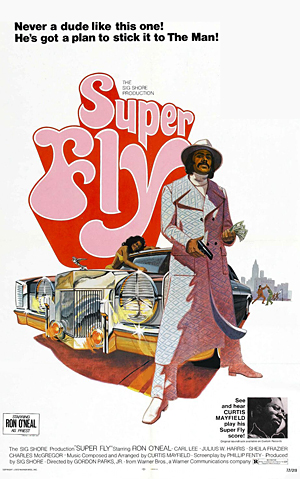Rather than sugar coating subject matter and attempting to be politically correct, exploitation films blatantly depicted drug use and violence forcing movie goers into situations they may or may not be comfortable with viewing. Blaxploitation does this just as any other films encompassed in the genre and, unfortunately, has gotten excess criticism from both film critics, advocacy groups and even Civil Rights leaders. Films like Dolemite, Blacula and especially Superfly have been said to further stereotypes, promote violence and generally cast Black culture in a negative light. However, what many fail to see is that movies like Superfly are truly liberating to the culture the film is targeted for and further more, a commentary on social lives of Blacks at the time. Much like H. Rap Brown’s, Die N!@@^# Die, Superfly is a commentary of two kinds of African American thought during the late 60s and into the late 70s.
Of the many positions taken in the book, H. Rap Brown argues that there were different kinds of African American mentalities during the Black Power movement. There were those who were ready and willing to fight for change and move away from a society dominated by white ideals and racism. Although, there were also those who were complacent with their lives and unwilling to take any stance against the race who continued to force them into second class lifestyles. These mentalities are clearly stated in Superfly and it is an issue that the protagonist, Priest, struggles with throughout the film. Priest is a streetwise cocaine dealer in the midst of making a life changing decision. Rather than continuing his life dealing drugs, fighting rivals and avoiding the corrupt police he decides to make one final deal and leave the life. The Priest character’s archetype is very similar to the second of the two groups mentioned in Brown’s book. Often times, African Americans tired of the white controlled system turned to drugs and crime. Rather than trying to better society, they often times made it worse, killing and corrupting others. The Priest, fed up with the white dominated society, had acquired a small wealth selling drugs. Although, after some time of dealing he realizes he is putting both his own life and the lives of other in danger.
It is at this point that Priest becomes some what of a black power symbol, slowly removing himself from his previous lifestyle, liberating himself from his white girlfriend; who is clearly using him for his connections in the drug world, and attempting to cast negative light on the corrupt, drug dealing police officers in power. Priest’s partner, Eddie, is his stark opposite in the film. Where Priest attempts to leave his old life, Eddie wants to delve deeper into the world after Priest and Eddie are forced into doing deals for the police. Eddie sees this as an opportunity for more wealth, where Priest knows it is truly a form of modern slavery; where the police are the masters and individuals like Priest and Eddie are the slaves and Priest is not willing to tolerate this abuse.
Curtis Mayfield composed and performed all of the songs featured in the film. The films main song, “Superfly”, sums up the issues faced by drug dealers on a day to day basis. The lyrics, “Hard to understand ,what a hell of a man, this cat of the slum, had a mind, wasn’t dumb, but a weakness was shown, ’cause his hustle was wrong, his mind was his own, but the man lived alone” illustrate Priest’s lifestyle as a hustler with a strong mind. He finally recognizes the wrong doings he has committed and must pull himself up from the streets. Similarly, the song “Pusherman” tackles other inner struggles faced by Priest. Lyrics such as, “been told I can’t be nothing’ else, just a hustler in spite of myself, I know I can rake it, this life just don’t make it” show white America’s perceptions of Black Americans who have given up on society. Powerful whites, at the time, felt that there was no retribution for those who committed their lives to crime and drugs. Furthermore, a statement is made that inner city African Americans are never given the chances of whites outside the cities; also a trend in Brown’s book. Black youths were often times told that there is nothing for them outside of inner city life. The expectations of those around Priest are to deal drugs, make money and risk their lives. Anyone who tries to leave the life will face scrutiny and they are actually expected to fail.
Overall, Superfly black America’s response to white America’s perceptions about inner city life. Superfly and the Priest are black America’s version of John Wayne, Clint Eastwood and Charles Bronson. The film defines ideas proposed by black power figures and does all of this while still incorporating an entertaining and engaging story. The film is also a commentary of the relationships between different groups of African American groups in violent times. It is a story about retribution and exceeding the expectations of both those in power and those around an individual. Using strong black power themes, a once corrupted drug dealer becomes a symbol of black strength and perseverance at a time when racism was at its worst

